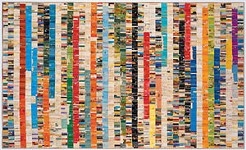A Piece of Work
There's nothing conventionally beautiful about Virginia Fleck's Indented Round Sod, a large, dun-colored disc of dried earth cemented together with mortar, and yet it exudes a strong, serene presence in its shape and balance of the natural and the manmade.
By Molly Beth Brenner, Fri., Aug. 29, 2003

Indented Round Sod
Sculpture of preserved sod roots and mortar by Virginia Fleck
at D. Berman Gallery, through Sept. 13
The sculpture I stand before is not a pretty work. Made of sod and held together with mortar, Virginia Fleck's Indented Round Sod is a large, dun-colored disc, utterly devoid of gloss or vibrant color. Gray-mortar veins spider through it like hardened arteries, and the fibrous, haylike quality of the loam brings to mind all manner of dead organica, from raw hemp to dirty human hair. Truly, there's nothing conventionally beautiful about a disc of dried earth cemented together.
So why am I still staring at it? The piece is like the face of a plain but kind old woman; there's something comforting and vaguely satisfying in looking at it. From the wall, it exudes a strong, serene presence that's difficult to quantify. This sense of comfort is partly due to its shape: a perfect, deeply familiar circle, whose mortared sections are as regulated as the spokes in a spider's orb web. The way it echoes the familiar, imperfect precision of natural forms makes it soothing to view. Also pleasing is the gentle indentation that appears near its center, a soft dimple that looks like it's been worn in by an undisclosed elemental process, just as the shoulder of a mountain grows smooth over time.
Yet largely what draw me toward this piece are the contradictory materials Fleck has used to create it. The purposeful, man-made mortar and the molded loam create a balanced, yin-yang effect when brought together, turning out an object that describes not the conflict between the civilized and the natural, but the possibility of new forms arising from the joining of the two.








